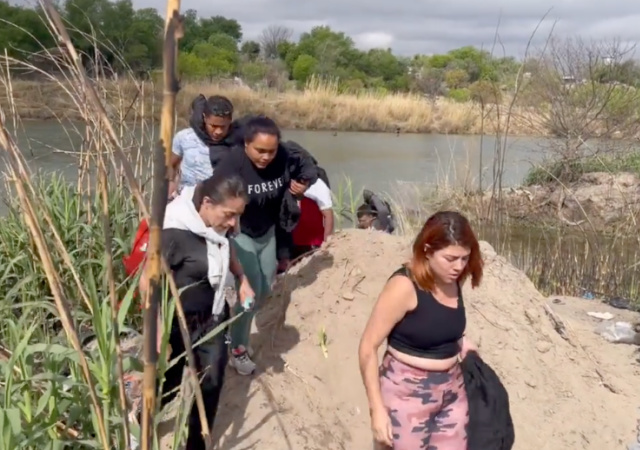DHS IG Found Numerous Mistakes Leading to Release of Migrant on U.S. Terror Watch List

How did a person on the U.S. terror watch list end up released and allowed to spend weeks in the country?
The DHS IG evaluated the situation. Let’s dissect the report.
What Happened?
If the Customs and Border Protection (CBP) in Yuma, AZ, had sent the Terror Screening Center (TSC) the information it requested, the agents would have known the migrant matched a person on the Terror Watchlist.
Instead, the agents released the migrant.
It all started on April 17, 2022, when the Border Patrol apprehended the migrant and began the record check process. The NTC wanted the Tactical Terrorism Response Team to interview the migrant.
Well, the NTC sent the email request to the wrong email distribution list for the Tactical Terrorism Response Team. An NTC official explained they have a lot of distribution lists for the Border Patrol, and not all NTC officers have updated lists.
So the tactical Terrorism Response Team didn’t get the request and didn’t interview the migrant.
The NTC also asked the Grupo Conjunto de Inteligencia Fronteriza (GCIF) for the information requested by the TSC. GCIF did so and gave the information to the NTC. Somehow the TSC never received the information. Two NTC officials told the IG office “they did not recall why they did not forward it to the TSC.”
The Yuma centralized processing center (CPC) did not respond to the NTC email asking for more information on the migrant. The report blacked out the exact information requested by the NTC.
One official explained the agents try to answer all the emails but guess what. They’re bombarded by migrants crossing the border.
What border crisis, right?
The Yuma CPC processed the migrant on April 18, 2022. The office then transferred the migrant for release on April 19, 2022, before the NTC and the TSC worked out everything.
How did this happen?
- 1. Yuma CPC lacked a decent method to flag the paper A-Files of those with inconclusive Terrorist Watchlist matches.
- 2. Yuma CPC was over capacity after “an increase in apprehensions, which created pressure to quickly process migrants and decreased time available to review each file.”
On April 21, 2002, the migrant tried to catch a flight to Tampa, FL. The TSA screening flagged the person as someone on the Terror Watchlist. The TSC finally had the chance to positively identify the migrant as someone on the watchlist.
ICE made the arrest a priority but had problems sharing information while planning and executing the arrest.
On April 22, 2022, An ICE Enforcement and Removal Operations (ERO) officer told ICE NRO Miami Field Office about the TSC identifying a migrant on the terror watchlist. That office asked the Tampa Field Office to arrest the migrant during their alternatives to detention (ATD) appointment on June 1.
But the ERO Tampa office scheduled the arrest date earlier “because the migrant was a positive Terror Watchlist match.” The report listed three concerns of the office but blacked out everything except that the migrant could be a national security risk.
So on April 26, 2022, the ERO Tampa Office handed the arrest to Fugitive Operations. Then this happened (emphasis mine):
On the same day, Fugitive Operations consulted with the Joint Terrorism Task Force, checked the migrant’s GPS location, and requested the migrant’s paper A-File from the ICE ERO Yuma Office. After completing these steps, Fugitive Operations placed the migrant under surveillance and received updates from the Tampa ATD Office to track the migrant’s GPS location.Although ICE prioritized the arrest, Fugitive Operations did not receive the AFile in the mail until 8 days after requesting it. Fugitive Operations wanted to review the migrant’s A-File before the arrest to enhance officer safety and help plan the operation. For example, if the A-File contained evidence that the migrant engaged in prior violence, awareness of this information could enhance officer safety during an arrest. The A-File could also have photographs to help officers identify the migrant during surveillance.Officials explained that the delay in receiving the A-File may have been because the ICE ERO Yuma Office receives approximately 1,000 A-Files once or twice a week from the Yuma CPC and must sort, box, and ship them to ICE ERO offices near migrants’ destinations nationwide. ICE officials said although they rely on A-File information to plan arrests, delays in obtaining paper A-Files are common. In fiscal year 2022, DHS piloted the use of electronic A-Files to streamline immigration processing at a Texas facility but has not yet expanded the pilot.
Can’t…can’t they scan and email the documents? How much money are these places receiving that they cannot hire more people?
On May 6, 2022, the Fugitive Operations also had problems accessing the migrant’s GPS data during the arrest because the agents requested the information hours before the Tampa ATD office opened.
Mistakes
1. CBP sent an interview request to the wrong distribution list
2. Didn’t share information with the TSC
3. Released the migrant before the NTC and TSC could finish their job
4. Mailing information to an ICE office prevented agents from quickly arresting the migrant
5. Give Fugitive Operations access to GPS data
The IG said DHS is working on “transferring migrant documentation electronically.” It’s 2023. Everyone has been sharing information electronically for at least two decades.
Fix It
The IG recommended (emphasis mine):
Recommendation 1: Develop and implement a process to maintain updated Border Patrol email distribution lists for NTC information requests.Recommendation 2: Identify and share best practices for resolving inconclusive Terrorist Watchlist matches before releasing migrants.We recommend the Director, U.S. Immigration and Customs Enforcement:Recommendation 3: Develop and implement a process to ensure ICE officers have immediate access to GPS data relevant to their law enforcement operations.
CLICK HERE FOR FULL VERSION OF THIS STORY